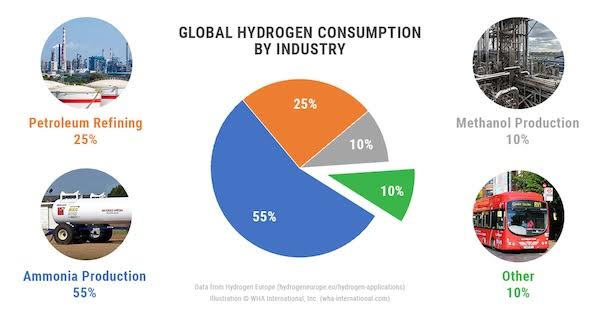Kubota Corporation has unveiled what it calls the world’s first hydrogen-powered self-driving tractor, a major step forward in addressing both Japan’s acute farm labor shortages and the push toward decarbonization in agriculture. The company presented the prototype at an expo in Osaka in 2025, marking a milestone in the intersection of clean energy and automation. Japan’s agricultural sector faces a significant demographic challenge. The average age of farmers in the country is over 67, and many rural communities continue to lose young workers to urban migration. As a result, fields are increasingly left fallow due to a lack of available labor. Industry experts and government officials have long warned that without innovation, Japan risks seeing its domestic food production capacity erode.
Kubota’s hydrogen-powered autonomous tractor is designed to fill that gap by allowing farmers to manage their operations with fewer workers. The machine can be monitored and controlled remotely, enabling a single operator to oversee several units at once. This innovation aims to relieve pressure on shrinking rural workforces while maintaining farm productivity. The tractor runs on a hydrogen fuel cell system, which generates electricity by combining hydrogen with oxygen. This electricity powers the machine’s drive motors and implements. According to Kubota, a single refill allows the tractor to operate for up to eight hours, roughly equivalent to a half-day of fieldwork.
Unlike previous autonomous tractor models that included cabins for human backup operators, this new version is entirely cab-less. It is guided by GPS, lidar, cameras, and artificial intelligence to perform tasks such as plowing, planting, and cultivating with high precision. Engineers also demonstrated its modular capabilities, showcasing how different implements, including planters and weeders that can be attached and detached automatically. Kubota representatives highlighted the tractor’s obstacle-detection technology, which enables it to identify and respond to unexpected items in its path. Demonstrations showed the vehicle adjusting course and resuming operation without human intervention.
The tractor aligns with Japan’s broader policy goal of building a “hydrogen society.” The government has invested heavily in hydrogen technologies, promoting their use in transportation, power generation, and now agriculture. Officials argue that hydrogen can help Japan reduce its reliance on fossil fuels and meet long-term emissions reduction targets. By applying hydrogen technology to agriculture, Kubota aims to create machinery that not only offsets labor shortages but also contributes to sustainability goals. The company has indicated that the tractor represents part of a longer-term strategy to develop hydrogen-powered solutions across its product line.
While the unveiling was widely praised as a technological breakthrough, several challenges remain. One major obstacle is infrastructure. Hydrogen fueling stations are still limited in rural areas, making it difficult for farmers to integrate such machinery into daily use. Analysts suggest that mobile refueling units, on-farm hydrogen production, or regional hubs will be required to support widespread adoption. There are also regulatory issues. Current Japanese laws restrict the operation of unmanned vehicles on public roads, complicating efforts to move autonomous tractors between fields. The government has begun drafting guidelines to permit driverless agricultural machinery under controlled conditions, but nationwide implementation is still in progress.
Cost will be a deciding factor in the tractor’s adoption. Early estimates indicate that hydrogen-powered autonomous tractors could cost 30% to 40% more than traditional diesel-powered models. While large-scale farming operations may be able to justify the investment, smaller farms could face barriers to entry unless government subsidies or leasing programs are introduced. Industry experts believe leasing may be a more practical solution, allowing farmers to access the technology without bearing full ownership costs. Additionally, cooperative ownership models, where multiple farmers share access to a fleet, could become an important part of the rollout strategy.
The unveiling comes at a time when the global market for autonomous tractors is expanding rapidly. Analysts project that the market could grow more than tenfold over the next decade, driven by similar labor and sustainability challenges in other countries. Other agricultural machinery manufacturers are also pursuing autonomous solutions, but most current models remain diesel-powered or hybrid. By skipping directly to hydrogen power, Kubota aims to differentiate itself as both an innovator in sustainability and a leader in next-generation farm automation.
Initial reactions from the agricultural community have been mixed. Technology analysts and environmental advocates have generally welcomed the development, calling it a bold leap that could inspire similar initiatives globally. However, they caution that the gap between prototype demonstrations and widespread adoption is often wide, citing the need for rigorous field testing and long-term durability data.
Kubota’s hydrogen-powered driverless tractor represents a significant innovation at the intersection of agriculture, clean energy, and automation. It addresses pressing labor shortages while aligning with Japan’s hydrogen society vision. Yet, challenges around cost, infrastructure, regulation, and farmer acceptance will determine how quickly the technology transitions from prototype to practical use. If successful, the tractor could reshape farming practices not only in Japan but also globally, offering a model for how autonomous, zero-emission machinery can transform agriculture in an era defined by demographic shifts and climate goals. And, yes, I suspect the further they build out the hydrogen supply chain, prices should start to come down. From my perspective, until they can show the total cost of operating an autonomous hydrogen tractor is cheaper than traditional diesel, they will struggle with adoption. But once they cross that chasm… things could quickly change. For me, I don’t typically like being one of the first ones through the door in regards to NEW technology. As I’ve learned, the first through the door are often the ones that get beaten and bloodied up the most… Lots to think about! (Source: hydrogenfuelnews, interestingengineering)







